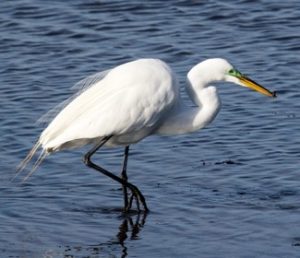Written by JJ Egan, BBP Field Specialist
For the last 12 years, the Barnegat Bay Partnership has conducted a seining survey of the fishes and jellyfishes that inhabit the bay. Initially, seven sites were sampled, but this has grown to 15 sites, ranging from Brick Township to Tuckerton. This year, we caught over 139,000 organisms from 64 different species. While the vast majority of these species were the usual suspects, such as bunker (Brevoortia tyrannus) and silversides (Menidia menidia and Menidia beryllina), every year we see a variety of more exotic visitors. While it is nothing new for species usually associated with lower latitudes to be seen in the Barnegat Bay during the warmer months, warming ocean temps have led to more of these “tropical” species appearing in the bay and staying for longer.

This year was no exception. Along with the expected southern visitors, two species, Gag Grouper (Mycteroperca microlepis) and Bigeye Scad (Selar crumenophthalmus), appeared in our sampling for the first time. Another new addition to our summer guest list, the dusky pipefish (Syngnathus floridae), made a big return this year after being recorded for the first time in 2022. The dusky pipefish is a member of the same family (Syngnathidae) as sea horses and the Northern Pipefish (Sygnathus fuscus). They are found throughout the bay and live along the bottom, especially in and around sea grass beds. With their long snouts and tiny mouths, they feed on small invertebrates, fish eggs and fish larvae.



Several Jack Crevalle (Carranx hippos) also showed up in our sampling this year, including multiple individuals that were caught at our most northern seining site, Windward Beach in Brick. While most of the Jacks that are seen each year in New Jersey are small, occasionally there are larger specimens caught, like the 15-pound Jack speared in Barnegat Inlet this year. Jack Crevalles are unique to most southern visitors, in that it is believed that they actually leave the bay in the fall and survive, instead of lingering to perish when the temperatures drop. The juvenile Jacks tend to seek out lower salinity areas when they enter estuaries, and some individuals have even been seen at the freshwater interface of the Hudson River.

Pinfishes (Lagodon rhomboides) have become a regular summer visitor to the bay. These small, colorful fishes are members of the Porgy family (Sparidae), along with Sheepshead. They are very common in inshore waters from the Carolina South. They are now seen as one of the “winners of global warming” as they have become more and more common in the bay, despite being thought of as a Southern species. The first pinfishes we see usually show up around the first week of June. While it is not entirely clear where they go when they leave the bay in the fall, some have been caught offshore of New Jersey in wrecks in over 200 feet of water. This year we saw several specimens of pigfish, which are regularly confused with pinfish. In fact, you may have seen a few pop up on various Facebook groups, typically people looking for identification confirmations.


We caught several Mangrove Snappers (Lutjanus griseus) this year, including two in Cedar Creek in the third week of October. Mangrove snappers are a very common inshore fish in Florida, and sought after as a food and sportfish. While they are not overly common in the Barnegat Bay, we do see a small number of young-of-the-year specimens in the summer and into the fall (even as late as November). Sadly, it is unlikely that these fishes make it back to warmer waters as they are most likely killed by cooling temps.

While the appearance of these fish can be an exciting addition to a day of sampling, their increasingly regular occurrence could be indicative of shifting community structures from climate change. While the effects of these shifts cannot be fully understood at this time, hopefully future monitoring will shed some light on this issue.


